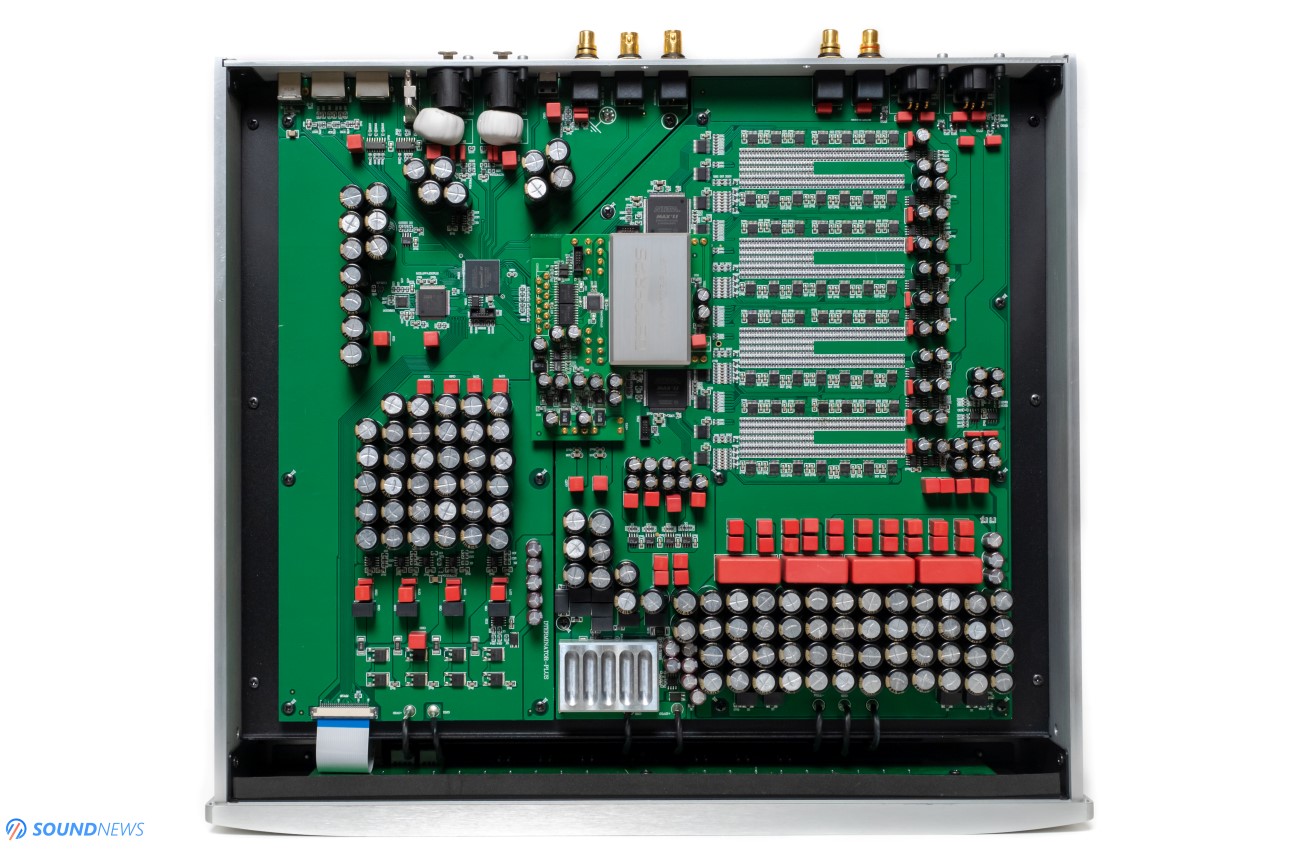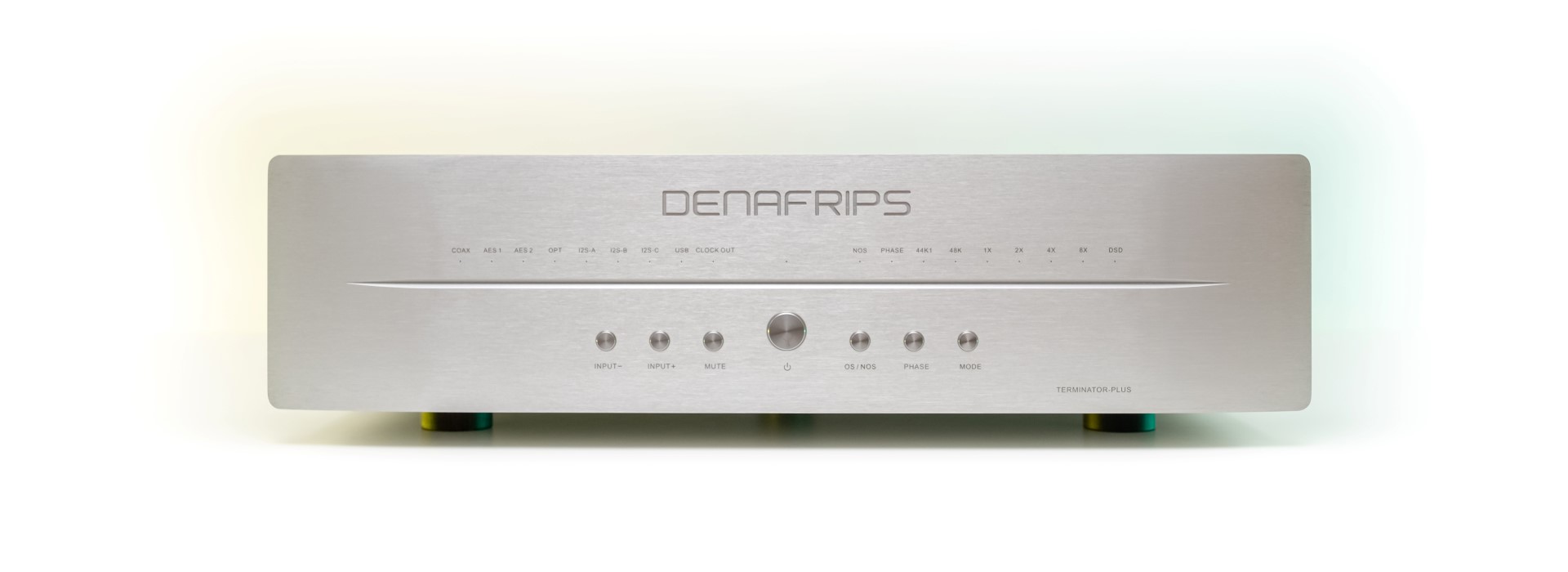
My Video Review:
After becoming an audiophile, James Cameron once called me and said:
- “Hey mate, I have this mind-blowing idea of resurrecting the action movie genre that redefined our generation!
- I’m all eyes and ears, I’ve replied back.
- How about John Conor travels back in time to 2018 and tells Denafrips to buy Cyberdyne Systems and instead of making killer machines, they would be making killer DACs that would terminate their competition for good?
- That’s a terrible idea, James, but a killer idea to name your D/A converter of colossal proportions”
I remember as if it was yesterday when one of my closest friends invited me for a listening session to his newest acquired MSB Analog DAC about a decade ago. I was rocking chip-based D/A converters at that time, thinking that nothing can beat the newest and coolest technology. ESS Sabre just unveiled their newest ESS 9018 PRO silicon and everybody was rushing to make such D/A converters for the masses, even though I had to try some of them. With all that said, R-2R ladder DACs were a black hole for me, a massive unknown that I’ve been studying for quite some time, but never had the pleasure of putting my ears on such units before.
The very first digital to analog converters started their life with a ladder of resistors and since then, the world made them smaller, we’ve got different flavors as oversampling and non-oversampling DACs, expensive R-2R networks were exchanged with smaller and cost-effective chip-based converters, others made their own software defined DACs by bending FPGAs to their will. I thought the newest technology should always be the coolest one…right? I believed transistors would obliterate vacuum tubes, op-amps would destroy transistors and D/A chips would send R-2R ladder DACs into the history books due a better measured and subjective performance and I thought that pilsner beer is the best beer…ever. Skynet was so wrong and so did I!
Lights were turned off and a single candle was put atop the MSB Analog DAC, the moment it started playing – was the moment I wired myself to the Universe, as I finally understood that good sounding DACs weren’t only about decoding as many zeroes and ones at a given time, but about all other things that could transform a common act, random soulless noises into a piece of art, that we tend to call music. Analog DAC made me realize that DACs aren’t only about unearthing as much information as possible, they were much more than that. Hundreds of DACs and a decade later, when a well-made R-2R ladder DAC hops on my table and starts playing, something…changes inside me that can’t be defined by mere words. It’s no longer about cleanliness, noise floor and detail retrieval, it’s about a huge wall of sound that hits you from multiple angles, it’s about a sound that’s bigger than life, that breathes and pushes your drivers and hearing abilities to their limits, it’s about butterflies in your stomach and feelings with every cell of your body. Still, due to a cheaper manufacturing process, chip-based delta-sigma converters took the world by storm. These are (still) extremely impressive when trying to bring forward a lot of information, without landing a critical hit to your wallet. Sadly, affordable R-2R DACs can’t do that as good and there are plenty of examples to give, but when trying to create eerie moments by putting goose bumps all over your body, nothing does it better than a no-compromise R-2R ladder DAC…and that’s the true story behind them.
But wait! I hear you screaming from afar. Sometimes there’s more information with units like Matrix Audio Element X, Gustard X26 PRO and to a lesser degree, Topping D90SE. That’s all true, but who cares about the smallest details, when music isn’t speaking to the inner self anymore? Aren’t you listening to music by awakening distant memories and feelings of joy or sadness? I must confess to you: I’m a goose bump whore and it seems that R-2R DACs and hybrid amplifiers are my fire starters as of late.
I’ve already covered quite a few R-2R ladder DACs by now, some of them were magnificent sounding like Denafrips Venus, Audio-GD R7 and Musician Aquarius. All of them had their pluses and minuses, but I feel that today’s unit terminates them all, climbing an aluminum throne as the best sounding DAC I had the pleasure of testing at my place. Denafrips Terminator Plus isn’t only their top-of-the-line unit, but all the knowledge and experience Denafrips engineers gathered in all those years. Terminator Plus uses an advanced 26-Bit true balanced R-2R configuration for PCM material, plus another 6 bits of resolution using 32 step FIR filters for DSD material. Instead of going with hundreds of 0.01% precision resistors as they did for Ares and Pontus, Venus and Terminator series are using the highest precision 0.005% resistors for a (much) clearer and airier sound. Terminator Plus (TPlus from now on) goes for 8.849 SGD (Singaporean Dollars) and its story has just begun.
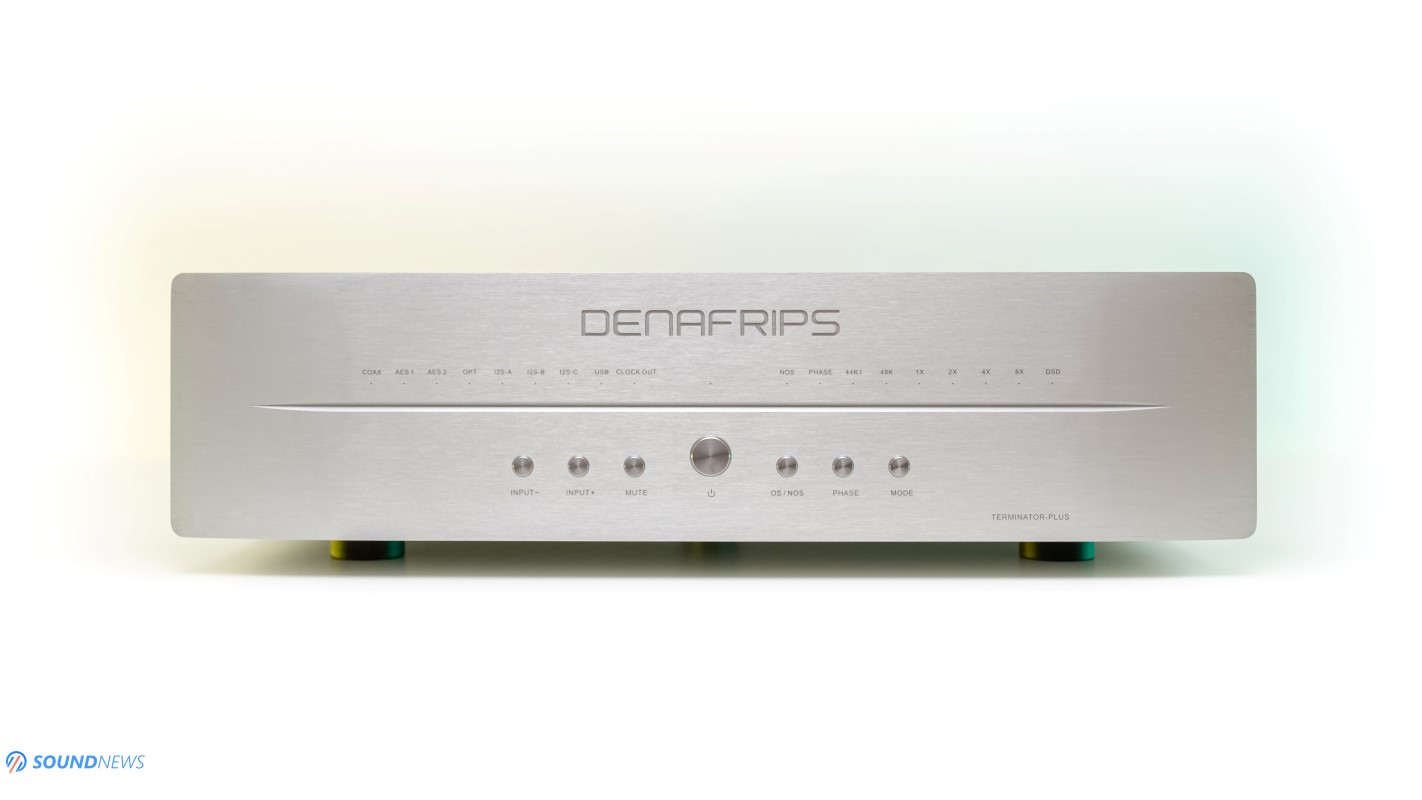
Unboxing a Beauty & Unleashing a Beast
Disregarding loudspeakers, the biggest box I ever received was for the Audio-GD R7 DAC that looked more like an over-the-top integrated amplifier. Now, imagine my reaction when a delivery guy calls and asks for help, as he couldn’t deliver the package to my front door. Could this be a Denafrips Thallo or Apollo, I thought? Nope! it was a 19-kilo cybernetic organism that dwarfed all other metal boxes I received so far. Naturally, it arrived in a massive blob of foam wrapped around it like a cocoon, so it would arrive safe and sound to my front door. It didn’t come with a USB or power cable, but at this level, I don’t see the point in using stock cables anyway. You won’t find a remote in there – since it can’t work as a preamplifier. If you would like to know more about it and its features, then go ahead and download its user manual from here and if you’re using a Windows machine as I do, then I recommend installing its Thesycon drivers that you can get from here.
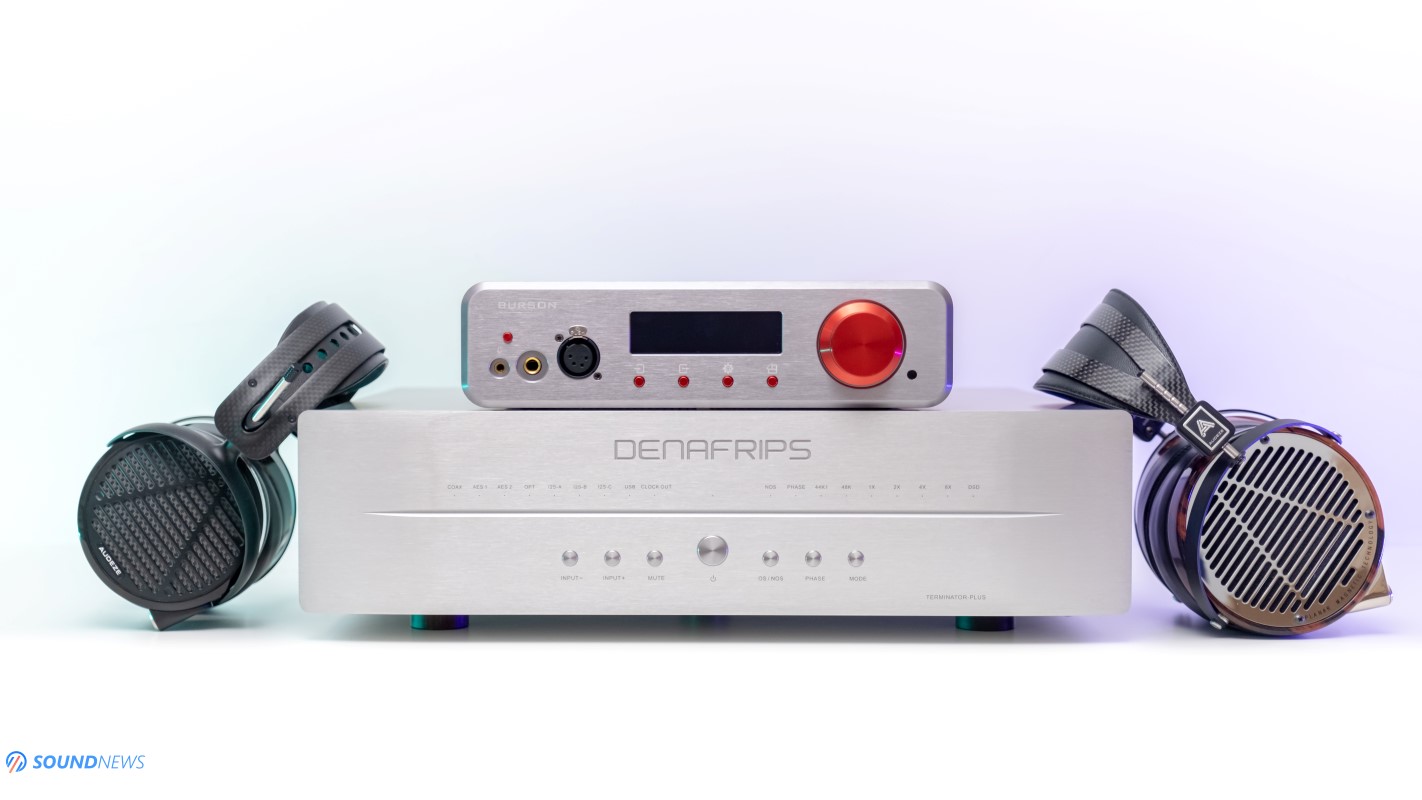
Design & Build Quality
I never seen a bigger DAC in my life. Everything is over the top about this one, you get thick aluminum plates, awesome metal feet and a gorgeous looking unit. It’s built like a tank and it feels like one when trying to rearrange it on the table. While it sounds like a diva after a few hours of warm-up, it fights in the heavy weight category with its 19 Kg body weight. This thing isn’t only the heaviest DAC I’ve tested around here, but the heaviest metal box that I’ve ever received for testing purposes. Even integrated and power amplifiers felt ashamed standing near it. It looks colossal & imposing and after putting it near my power amplifiers, I started realizing how big it really is. It dwarfed everything I have for testing and it occupied about one third of my desk space.
At 1 cm and a half, it has the thickest aluminum front plate (their Venus DAC has a similar front plate) and its whole structure will likely last a life-time. Its case feels like a faraday cage, so you can forget about EMI or RFI noise crawling inside.
It’s common practice hiding every screw on a back panel for a clean and minimalist look and somebody should probably wake-up Audio-GD (I’ve tried!), as they are still living in 2010s with screws placed all around their cases. Its low intensity LEDs have the perfect brightness in a dark environment and I dig their red light – very T800 if you ask me. I always liked the raw aluminum look, but you can also get it in an anodized black finish if you please.
As Venus before it, Terminator Plus prides itself with rounded edges, so it will not damage precious equipment when handling it around. It has flushed buttons that are providing a satisfying click and I find them firmly attached to the unit, without wobbling around. It consumes only 20W, meaning that heat dissipation isn’t a concern as it happened with other units like Audio-GD R7 and Gustard X26 PRO, it gets barely warm after a week of non-stop music playback. You can put anything on top of it, even hot integrated or headphone amplifiers if you will.
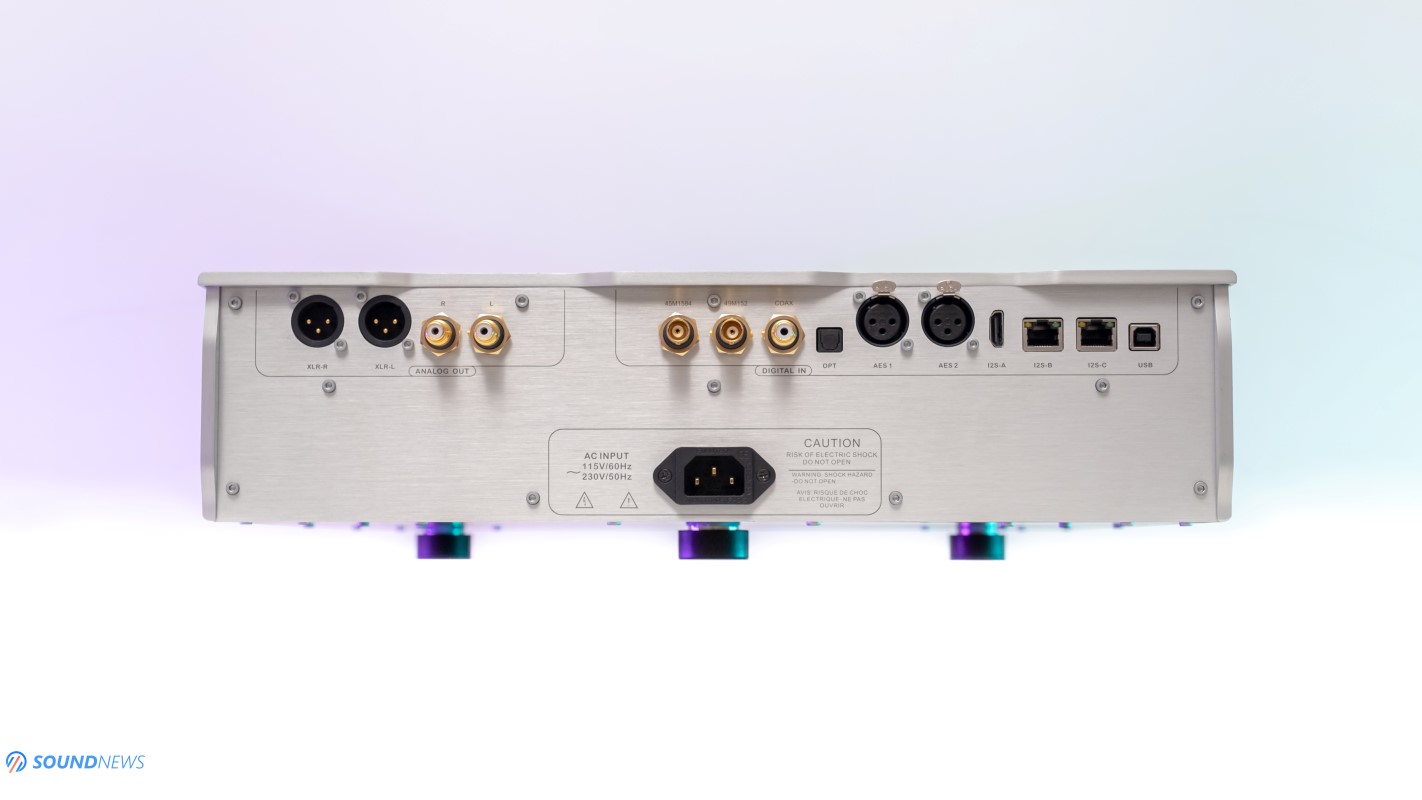
Controls & Connectivity
We are dealing here with a pure-hearted DAC with no additional features and maybe that’s for the best, as the signal path gets shorter. It doesn’t have preamp functionalities, so you can forget about volume controls and about a remote control for that matter.
Its front panel looks busy at first, but most of these are set and forget. From left to right you have your digital input selectors (shown by an orange LED on top), Mute and stand-by buttons are coming next. I’ve used its OS/NOS button the most that will turn on oversampling or disable it completely (LED on = NOS mode is engaged), Phase and Mode buttons are your last. If you’ll be using the TPlus with a DDC converter or wireless streamer via I2S (HDMI) input, then Mode button will come to the rescue, please check its user manual for additional details.
On its back you can spot every single digital input in existence as: USB, Coaxial, Optical, two AES inputs, three I2S inputs via HDMI and Ethernet and two BNC clock inputs – just in case a Denafrips Gaia DDC will hop on your shopping list. On the analog side you have your usual RCA and XLR outputs that are providing a fixed voltage of 2V and 4V respectively.
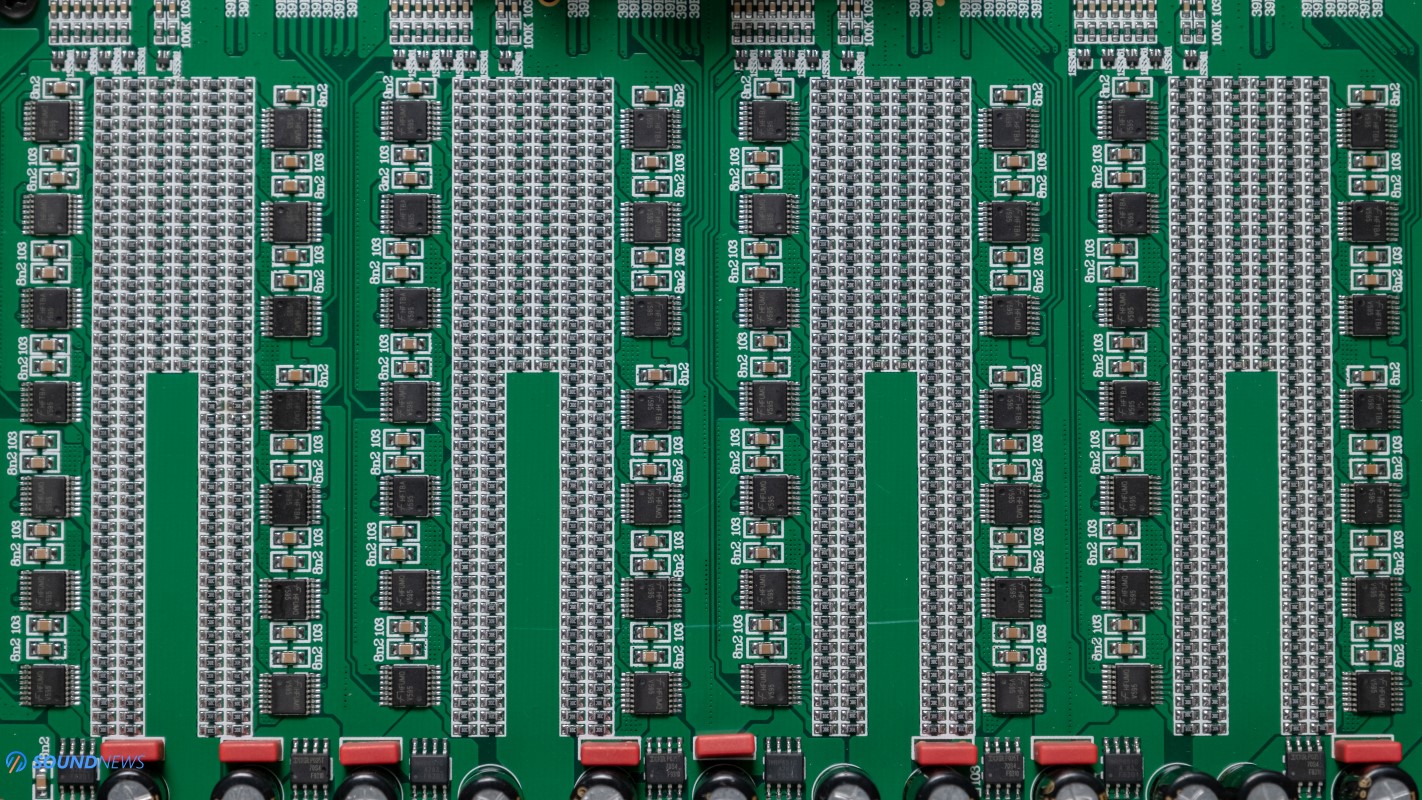
Under the Hood of T800 Plus
Considering the custom nature of R-2R ladder DACs, you will hardly find two similarly looking units on the inside. I’m getting bored looking at chip-based Delta-Sigma DACs, as most of them are looking more or less the same, with little to no differences. As you already know, R-2R ladder DACs are using resistor networks (also called as ladders) that will decode zeroes and ones into analog signals. Denafrips wanted to offer the most life-like and believable sound that would stretch wide open, nicely filling the room with music and that is precisely why four R-2R ladders made their way inside, meaning that we’re dealing with a true balanced topology. The higher the precision of its resistors = a higher resolution could be obtained from the ladder. Denafrips is acquiring thousands of resistors, but the best ones that achieve a precision of 0.005% are being used in the Terminator and Venus series and the rest are going into their Ares and Pontus series. Hand picking and measuring hundreds of resistors is a very tedious and time-consuming process and you can spot the same resistors in some of the best R-2R units of today.
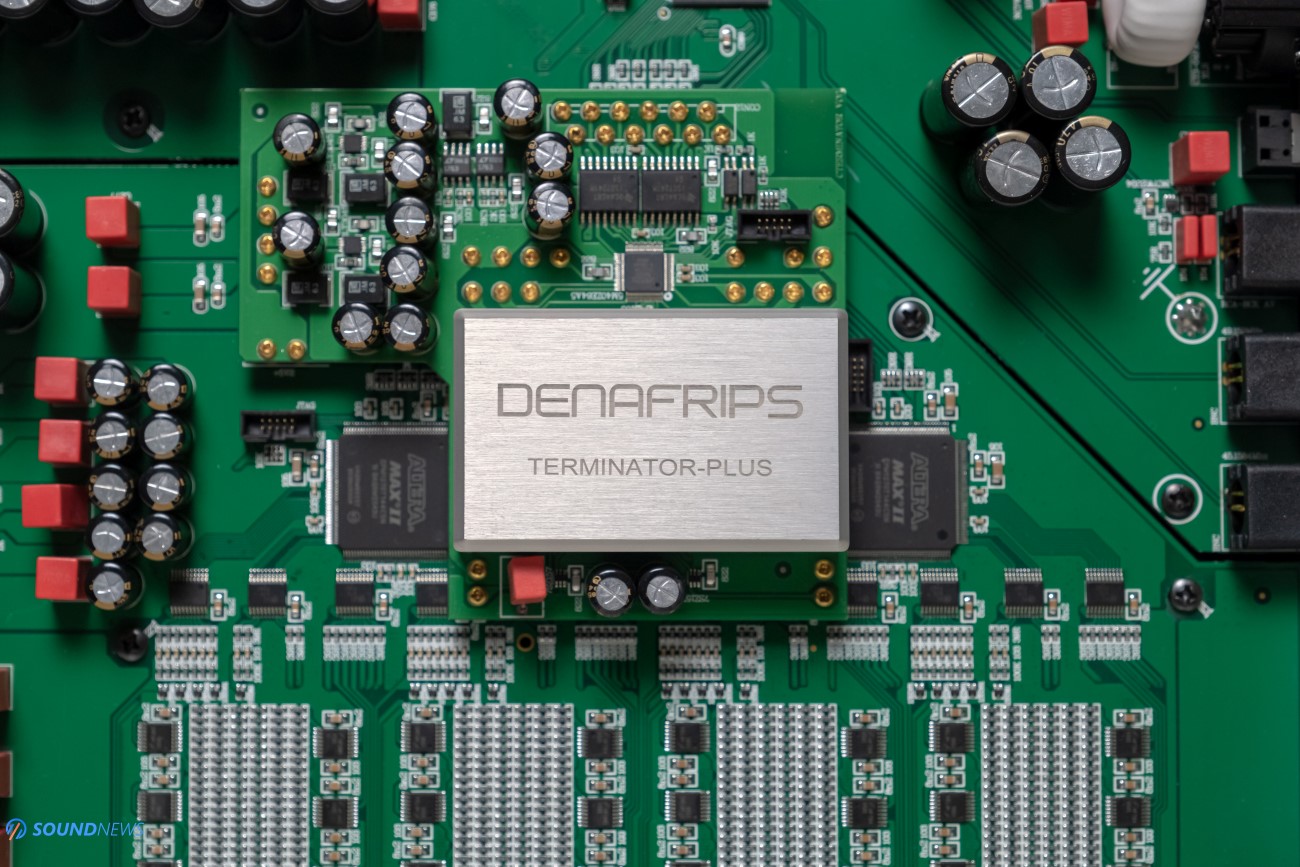
The second most important part of a DAC are the clocks that are being used inside. The unit that I’m testing today is equipped with dual OCXO operating at 45.1584Mhz, 49.152Mhz – 1024 times the sampling rate of 44.1kHz and 48kHz, encapsulated in a metal casing and located at the center of the DAC. These extremely expensive OCXO are specially designed for high-end audio applications with ultra-low phase-noise and ultra-accuracy. The dual OCXO are powered by a completely redesigned power supply circuitry (encapsulated, shielded, underneath the main boards), supplying constant current to the OCXO.
The digital receiver board of a DAC is usually made by third party company like Amanero Technologies, M2Tech, but most of them are using a time-tested XMOS interface like XU-208 or XU-216 – which can be found in affordable and super expensive DACs of today. Denafrips didn’t walk the same path, as all their units are using a custom-made USB interface that uses the full-bandwidth of the USB 2.0 standard. This is a future-proof module that supports the highest possible sample rates as 1536 kHz 32-bit PCM and DSD1024 (x8).
Last, but not least, we’re dealing with a state-of-the-art power supply that occupies the whole lower floor of the unit. It’s an encapsulated and linear power supply that is shielded by a thick steel plate. The box-within-a-box design eliminates the issues of dual box solutions and its oversized dual O-Core transformers (one for the analog board and one for the digital board) provides clean power to the most critical parts of its digital and analog sections. You can spot several regulation and filtering stages by some of the best ultra-low ESR and long-endurance capacitors, ensuring the cleanest power delivery.
It’s important to know that TPlus isn’t using a single op-amp in its output stage, you can spot several discrete components (transistors) that are working as mini amplifiers, buffering the analog signal to the industry standard 2V via RCA and 4V via XLR. This is an impressively crafted unit with some of the best components I’ve seen as of late. I don’t see rushing, only a well-thought internal layout with extra care put into its power supply implementation. Its capacitance seems much higher to any other Denafrips unit and that’s a very comfortable sight.
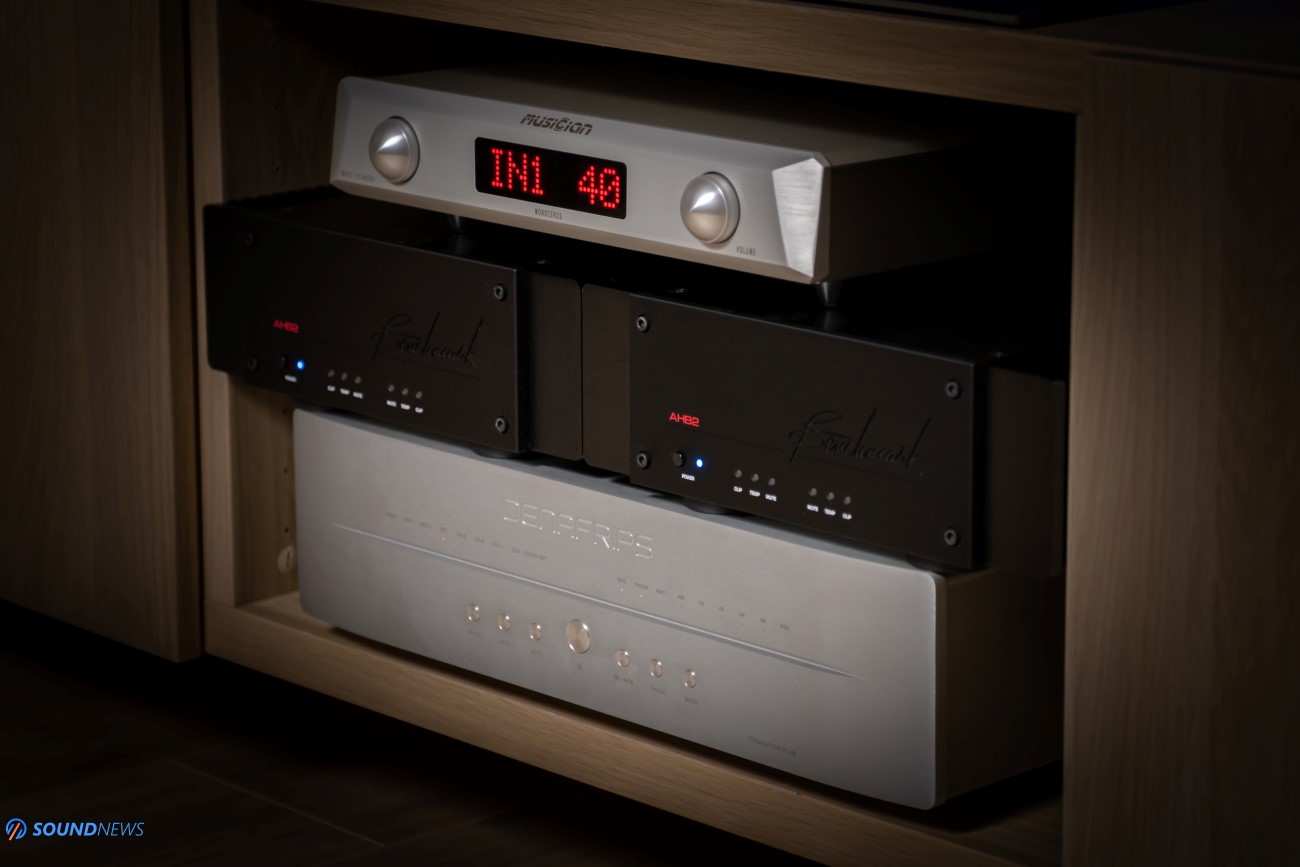
Test Equipment
I’m spotting technicalities much easier in an end-game headphone setup, as I feel that detail-retrieval, transparency, transient and frequency response are a child’s play for something like a Hifiman Susvara being driven by a Trafomatic Primavera or Enleum AMP-23R. In a loudspeaker setup it was much easier getting the feel of its soundstage size, depth and pin-location (imaging) of all the musical notes and that’s exactly why it was used in two distinct setups.
- In a headphone setup, TPlus was connected to a Trafomatic Primavera driving the most inefficient headphones, the legendary Hifiman Susvara. I’ve also tried the Audeze LCD-5, Kennerton Rognir (planar) and Erzetich Phobos V2021. First ones for sublime technicalities and detail-retrieval and later ones for outstanding bass and midrange presence.
- In a loudspeaker setup, TPlus was connected to a Musician Monoceros preamplifier, followed by two Benchmark AHB2 power amplifiers, driving a pair on KEF Reference 3 or Reference 1 Meta loudspeakers. Everything worked in balanced mode only, as TPlus offered a nicer performance via XLR, a lower channel cross-talk and a higher dynamic range can be achieved via its XLR connection.
Okay folks, my ears are begging for some well-deserved music, so let’s hit some ear-drums!
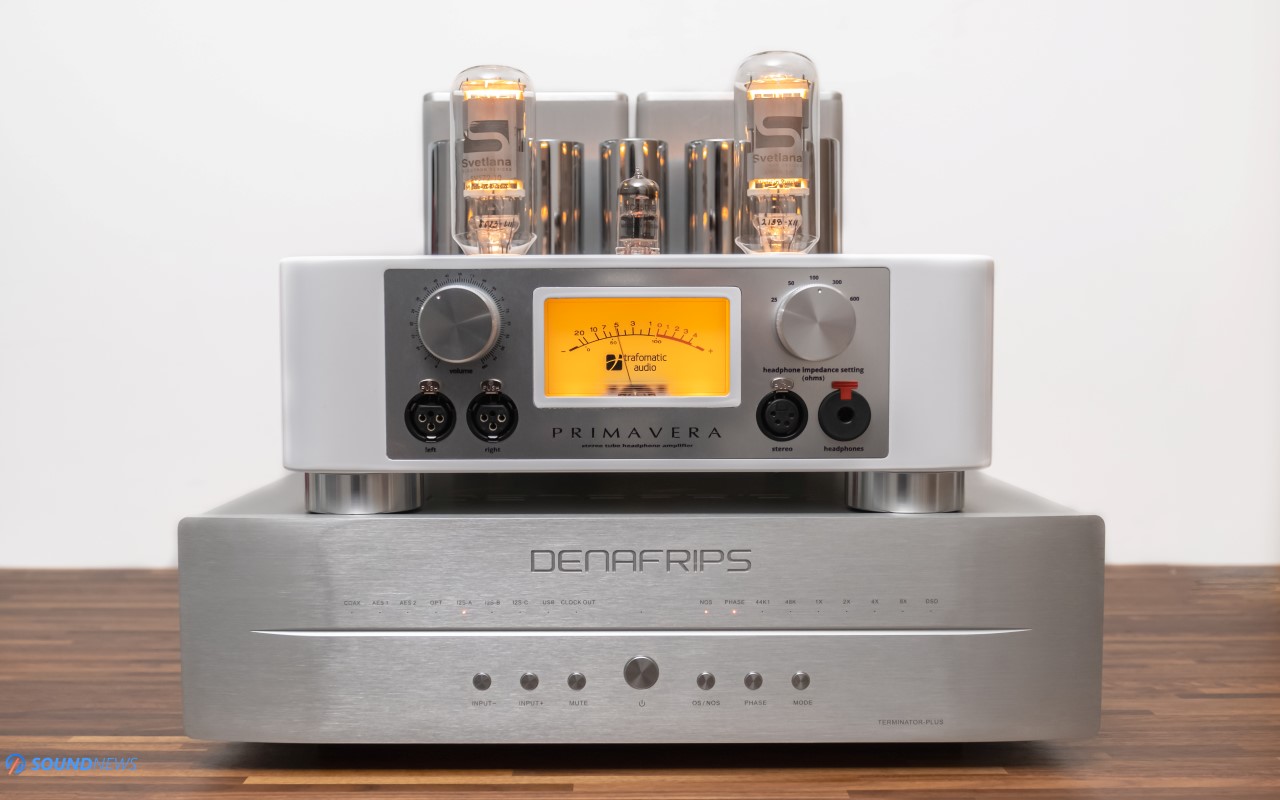
Sound Performance
I. Preliminary Sound Impressions
Before going deep into the rabbit hole with sound impressions, I believe I just experienced one the most expansive, airy and well-spread sound I had the pleasure of hearing in my office. Trafomatic Primavera and TPlus are doing it so well, that the second-best setup is far away from this one, especially when it comes to imaging and depth. The change was so big and immediate to regular D/S converters that I needed to relisten a big portion of my music collection that I know for a lifetime. Even oversimplified rock and pop tracks were filled with so much more air, like I was no longer wearing open-back headphones, but a well-made near-field setup was standing in front of me. There aren’t only bigger void spaces in between each and every note, but the experience itself was deeper and bigger on all axes. Even bad mastered music had a different meaning and I could finally see its beauty.
The second though that hit me – digital glare was forever gone. You can go as loud as you please and yet, there’s no hardness and no harshness whatsoever. Everything that was harsh before, feels like discovering a new treble shimmer, that’s beautiful and defined. What was teeth clenching transformed into beautiful intricacies that Delta-Sigma DACs couldn’t portray as natural and real. After hearing some of their units, TPlus isn’t reminding about their Venus or Ares. This one added a much-needed weight and punch in the lowest octaves, something that was seriously lacking on the Ares. I remember clearly trying a few electronica tracks and feeling a little disappointed for the lack of oomph and weight in the lowest octaves, something that Audio-GD R7 was doing better by a long shot. The depth, definition and texture of the low-end was improved considerably, so much so, that’s almost impossible listening to music through it without turning your head, smiling or toe tapping. This isn’t the most neutral sounding DAC out there, but it’s so organic and real sounding, it feels like skipping veggies and eating pudding instead.
Denafrips Venus wasn’t the most technical sounding unit out there, as upper-class delta-sigma DACs like Matrix Audio Element X, even affordable units like Gustard X26 PRO outperformed it at detail retrieval, transparency, speed and impact…but that’s no longer the case with Terminator Plus. The amount of information that comes forward is staggering and as much as I liked the Musician Aquarius and that yummy sounding Rockna Wavelight, Terminator Plus goes a little higher, delivering a clearer, a punchier and a faster overall performance.
After trying a bunch of albums covering most musical genres, I’ve observed that it was both relaxing and visceral sounding. It was sweet and smooth sounding with soprano voices and bombastic, to a point of becoming punchy with gangster blues and rock. Usually, it’s one or the other, but Terminator Plus gets them both. This is not your overly smooth Ares that’s shy on dynamics and detail retrieval or the slow-moving Venus, nothing is holding back its performance anymore.
When I received the Audeze LCD-5 a few weeks ago, I was…disappointed, as everything that I loved about the LCD-4 was forever gone. Sub-bass was lacking energy and oomph and depth felt downgraded as if I’ve got semi-open headphones instead. When Trafomatic Primavera finished its long burn-in period, I decided giving them another chance and I’m glad I did. I expected that LCD-5 would respond immediately to a better amplifier and DAC…but I was not expecting taking a 180-degree turn. Depth and stage height improved tremendously and from a closed-in performance, music started hovering around my head, picking only the notes I wanted to hear first. From a dead-neutral headphone to a point of becoming boring sounding, TPlus added more air, improved their leading edge and muscle mass by adding more energy in the bass and midrange, while gently slashing remaining treble itch. LCD-5 weren’t only better sounding, as I started enjoying them tremendously, I could finally understand them and see their true beauty.
A KEF Reference 1 Meta review is also in the making, I have them for more than a week and compared to mid-level sources as SMSL DO200 and Gustard X18, Terminator Plus was adding a lot more meat on their bones. Reference 1 sounded decent, but ultimately flat and uninvolving with previously mentioned converters and it was a merrier story with the Denafrips unit in place, revitalizing them to a point of becoming euphoric and pleasing in the long run.
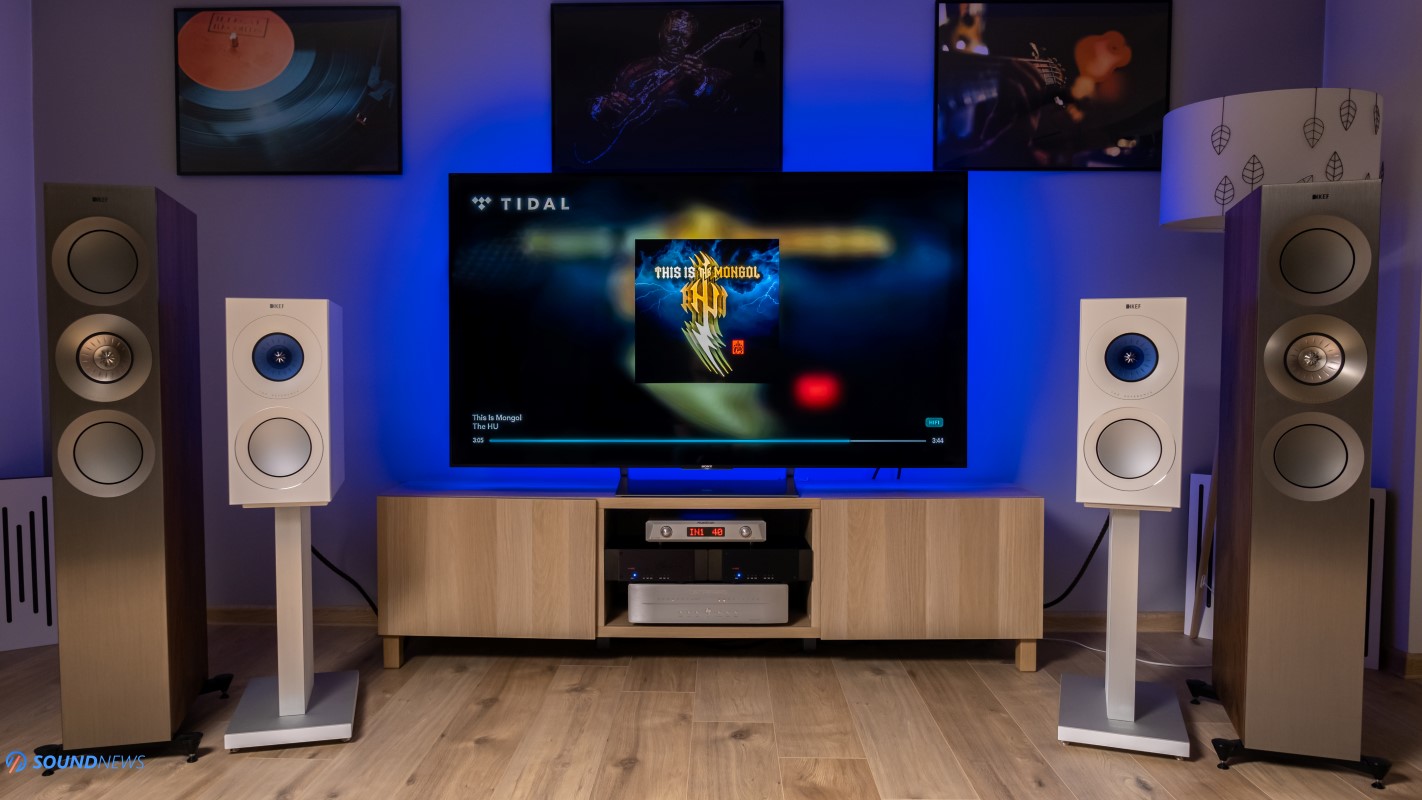
II. Terminator Plus in a loudspeaker setup
Denafrips Terminator Plus, Venus, Ares, as many other R-2R converters isn’t coming with a preamplifier circuit, there’s no way way to control its volume, as it outputs a steady 4V on its XLR and a lower 2V on its RCA output. To be used in a stereo, you’ll need an integrated amplifier or if you fancy the high-end route: you’ll need a preamplifier, followed by a power amplifier (or two in my case). I’ve used an all-discrete Class-A preamplifier that was connected to my daily driver Benchmark AHB2 mono amplifiers.
As you already know, most oversampling DACs with delta-sigma modulators have a simplified volume control, bypassing the need of a dedicated preamplifier. However, most of these units are using simple digital attenuators to reduce their voltage and subsequently their volume. Most of them don’t have line-amplifier circuits or a very precise volume control, slashing bits of information when driving power amplifiers. Those units will be gently pushing the brakes, lowering the speed, impact, they won’t control speaker diaphragms as good as dedicated preamplifiers would do. If I would choose between a DAC with a fixed voltage output versus one that has a mediocre volume control, then I would choose the first option without thinking twice. Lacking a preamp isn’t a huge drawback, as there are so many options at our disposal. From affordable preamps like Topping PRE90, to higher-end units like Denafrips Hestia, Hades or Athena, to dead-neutral units like Benchmark HPA4 and to smooth and relaxing sounding all-tube / hybrid preamplifiers, sky and your wallet are the only limiting factors. All these options would improve driver control, transient response and subsequently – sound quality.
As I’ve mentioned before, Denafrips best sounded massive, open and wide, as if I had no walls in my room, pulling and pushing air so easily, adding space where there was none. it sounded bigger to the usual converters that were staying on my table, including that majestic sounding Gold Note DS-10 Plus and the buttery smooth Audiobyte HydraVox. It increased the stage size in the living room and I’ve got the same feeling in my office. It sounded livelier, bolder and wider to the usual suspects that were staying nearby. It was just by a hair smoother and considerably more impactful to the Gold Note DS-10 Plus that I’m using as a streamer, DAC and preamplifier in my stereo rig.
KEF’s Reference aluminum woofers are known to be utterly transparent, quite neutral, clean and speedy sounding at all times, but they need help in bringing some refinement, midrange presence and for that you’ll need an organic sounding DAC or amplifier. AHB2 are dead-neutral to a point of becoming invisible in my chain, meaning that I can beautify my music with the help of a natural sounding source. In my setup, Terminator Plus worked as the blue pill that doctor prescribed, leaving the Reference 3 sparkly up top, while infusing more soul and energy into the midrange. Terminator Plus was making sure that dynamics would go up and down and nothing would stop from reaching their peaks. Its mild bass and midrange boost worked as a cure, adding warmth and a sense of calm to a dead-neutral setup. When I’ve went much lower on the volume, all the smallest nuances didn’t run to the shadows, they were still lingering around my room, whispering in a language that I understand so well. I was surprised how balanced my setup sounded in the evening at a much lower SPL. All the fullness and midrange density that Terminator is capable of wasn’t toned down, not by a single notch. The warmth and naturalness that was coming out of those metallic drivers was through the roof! Never I’ve believed that Reference 3 could sound so smooth and relaxing with the right music and selection of electronics. Considering the Class-A working principle of the Monoceros, it shouldn’t come as a surprise that I’ve got a denser type of sound, filling the gaps in the room, bringing forth a feeling of calm and easiness, while disentangling even the most crowded music out there.
It should be clear by now that it performed flawlessly in my loudspeaker setup, as it felt noiseless, impactful, technical, but also musical sounding.
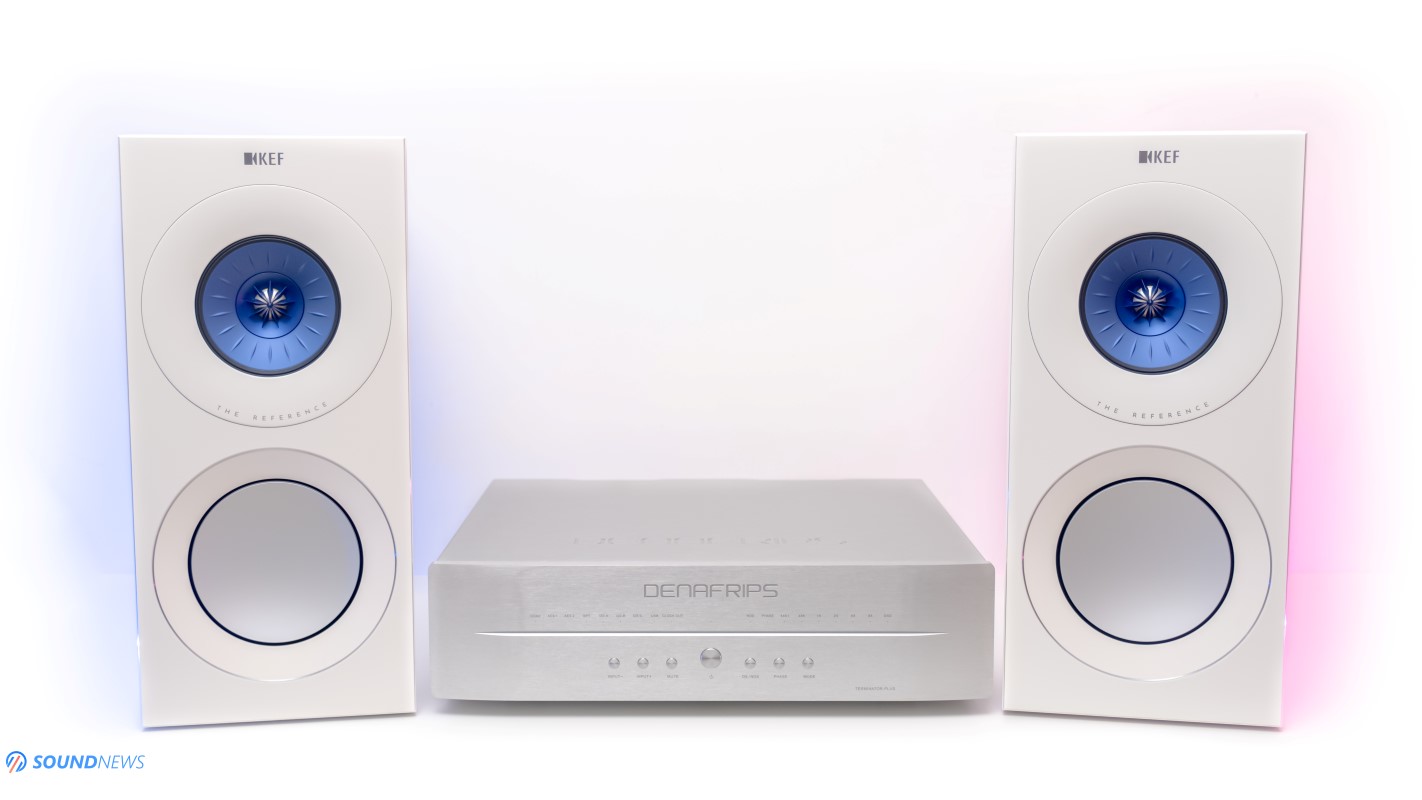
III. Noise Floor
An overkill and over-engineered power supply is sitting in the Terminator Plus. There’s a PCB that stays on the bottom of the unit, its whole area is populated with audio-grade capacitors, voltage regulators and oversized O-core linear transformers. This unit adopts a box-in-a-box design, since its power supply is encapsulated and shielded from the rest of the electronics. Add some of the best oven-controlled clocks (OCXO) and you are getting one of the cleanest and noiseless performance that I’ve experienced in a headphone or stereo setup. Connecting it to a Musician Monoceros preamp, followed by two Benchmark AHB2 power amplifiers didn’t increase the noise floor, not even a tiny bit. I’ve paused my music and went close to maximum volume, blasting 380Watts into the Reference 3 and Reference 1 Meta…and yet, their Uni-Q drivers were silent as Muscovy dusks. There weren’t hisses, nor hums with or without music playing in the background and if you’re searching for a dark background that wouldn’t increase the noise floor with sensitive loudspeakers or headphones, then I can’t recommend you enough the Terminator Plus. It shouldn’t come as a surprise as its overkill power supply is drowning the noise into the abyss, never to be spotted again. At a signal-to-noise ratio of 127dB, you can blast a hole into your eardrums trying to hear traces of noise with this one. All things considered; I would be surprised hearing anything less than a noiseless performance in any stereo or headphone setup. Adding a smartphone on top didn’t add hum and all I’ve heard was a clean, undistorted sound that never stood in the way. Background noises were nowhere to be spotted and that’s all you need to know about it.
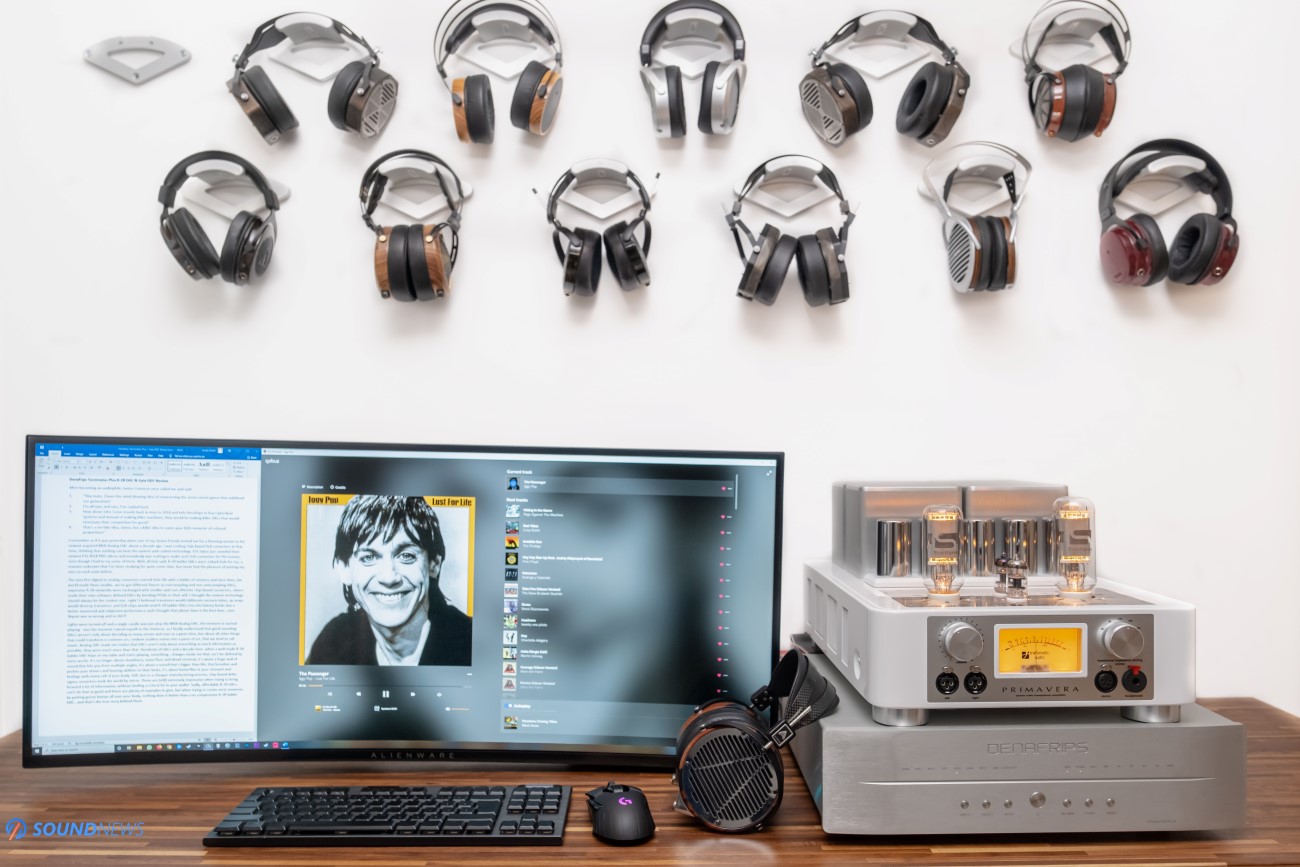
IV. Transient Response
I like the boldness and naturalness of R-2R units, the only two things I don’t like about them are: a weaker detail retrieval and a slower transient response. Generally speaking, these units are nowhere as impressive as well-made D/S DACs are performing. Remember, there’s always a compromise no matter the technology that is being used. My former Matrix Audio Element X was an extraordinarily fast and nimble sounding source, it was one of the cleanest sounding units too, but it wasn’t the hardest slamming unit out there. Often times, with R-2R it’s the other way around.
Making fast sounding R-2R units is a lot more complicated to regular (chip-based) converters, as we’re dealing with a longer signal path that needs to pass two to three times the number of components. With R-2R ladder units, component selection is crucial, as every stage degrades and slows down the signal little by little. Choose lower quality components (for ex: high ESR or high impedance capacitors) and you’ll be bottle-necking its transient delivery. With all due respect to Denafrips and to their past doings, Ares and Venus (first generation) couldn’t keep up with lightning-fast tunes…Ares was lacking speed and impact with my electronica collection, while Venus was lacking (only) in the speed department, delivering all the bass energy I dreamed of.
Terminator Plus doesn’t have such constraints anymore, it doesn’t round the frequency extremes as its smaller brothers were doing, it doesn’t slow down, nor does it soften transients’ energy, offering all the speed I wanted, a heftier punch via headphones and a substantial kick in the chest via loudspeakers. As far as R-2R DACs go, from the ones that I’ve tested around here, Terminator Plus takes the spot as the hardest slamming DAC that will immediately impress transient nuts like myself. In absolute terms, comparing with the best of the best, I still think top-class Delta-Sigma DACs are outperforming it when it comes to speed and Terminator Plus outplays them when it comes to raw slam and body kicks.
The amount of raw energy that was oozing from Terminator Plus felt through the roof when listening to heavy guitar riffs. Hora Lentă by Dirty Shirt (Tidal) just appeared on my playlist – a local folk metal tale mixed with mămăligă and palincă. The bass, rhythm guitar and cimbalom were so dirtylicious, raw and primordial…I just couldn’t get enough of them. I felt a powerful force moving forward, the stage opened up substantial, a richer tonality was oozing from this tune, while relaxing me completely.
Whitewash by Buckethead (Qobuz / Tidal) is not an overly complicated track by any means…but the way Brian’s drums started pounding my chest from the first seconds wasn’t a joke anymore. The drum work was exceptional, focused on a more energetic style, with upbeat guitars paying in the background that helped giving this track a very energetic feel to it. His guitar felt considerably heavier and snappier sounding compared to lower-grade DACs that are still awaiting their turn. It has a bucket filled with uniqueness and flavor that Terminator Plus masterfully painted. I prefer listening to this album when I’m emotional and nostalgic about parts of my life. It is a beautifully constructed album with a major emphasis on echo effects, which become a staple in Buckethead’s repertoire.
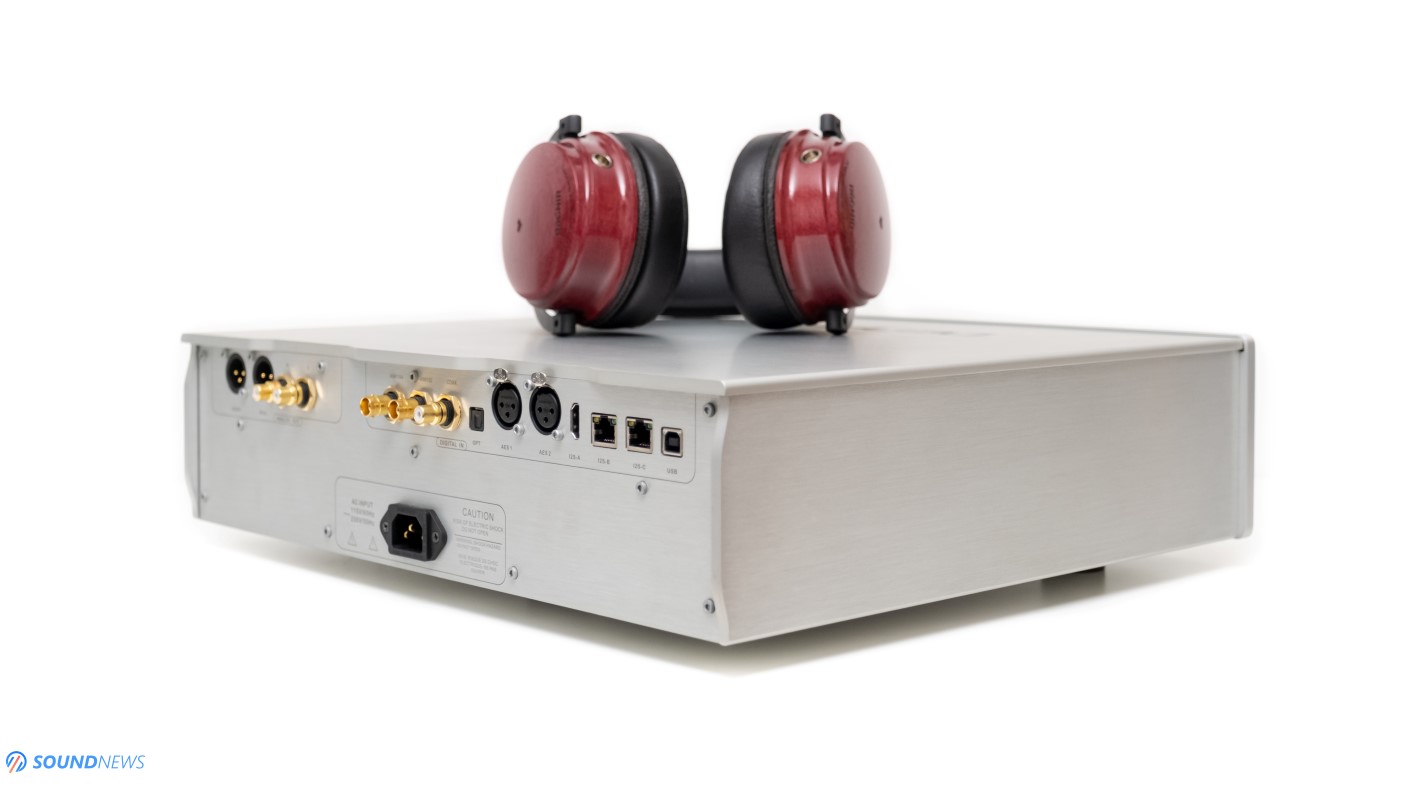
V. Soundstage & Depth
Maybe I’m not getting the last drop of information or the fastest transients out there, but when portraying a picture in front of me, Terminator Plus does that on a different, much higher level, to all other units that were tested around here. I don’t recall hearing my headphones so spacious, so airy and well-spread around my head. Trafomatic Primavera is obviously giving a huge helping hand, but I can’t deny a massive sound scape that comes within its all-discrete output stage. Live recordings and well-mastered music could envelop my head with a nicely designed DAC, but Terminator Plus envelops my entire body with its ethereal-like sound.
Audeze LCD-5 aren’t particularly impressive in this department, sounding mostly inside my head with a mid-fi setup, yet Terminator & Primavera are making them way bigger, layered and airy sounding even with oversimplified pop and rock tunes. This shouldn’t come as a surprise, as the biggest sounding DACs were always upper-class R-2R units. It is incredible how much air is still hidden in there somewhere. When it comes to pin-point imaging, soundstage & depth, KEF Reference 1 Meta are impressive on their own, but when I’ve replaced the Gold Note DS-10 Plus with the Terminator Plus, I felt that I swapped them with my own Reference 3 floor-standing loudspeakers. Spaciousness was dialed up to eleven, music was no longer playing on a bi-dimensional field, a deeper and a more layered sound revealed its identity, as there was more music lingering around my room. Long story short, Terminator Plus reigns supreme in here, closely followed by a Rockna Wavelight, Musician Aquarius, Audio-GD R7 and Denafrips Venus.
When I’m testing the scale of my music, for some unknown reasons Wardruna keeps calling my name with their latest Kvitravn album (Qobuz / Tidal). If you ever tried a Wadruna album before, then you already know how spacious and big all their tracks are sounding. If there’s a definition of a legendary sound, that’s the sound of Wardruna for me, that flies all around in either a headphone or speaker setup. After closing my eyes, music was coming from everywhere as if the band made a circle around me and started singing. Music was coming from different inception points like I’ve changed my closed-cabinet speakers with open-baffle ones. The sound was breathing as the Terminator Plus made the whole experience more special to the usual DACs that were sitting on my table.
That Nils Lofgren (Qobuz / Tidal) track followed; that sweetened and smoothed out the final outcome. Nils voice and guitar felt so deep and textured, always drawing my full attention to them. This time around the lights were turned off, moving the spotlights only towards his voice and guitar that were completely centered, as all else was scattered around the room. Guitar vibrations were longer and more emotional sounding to me, midrange to treble transition was smooth as butter, without dropping or rising any particular region. Reference 1 Meta were outputting an obscure amount of air, as if the music was decompressed and stretched wide open. The usual greyness and compactness of delta-sigma converters was no more…not even a trace and everything that remained was a highly transparent sound that wasn’t hitting an imaginary wall.
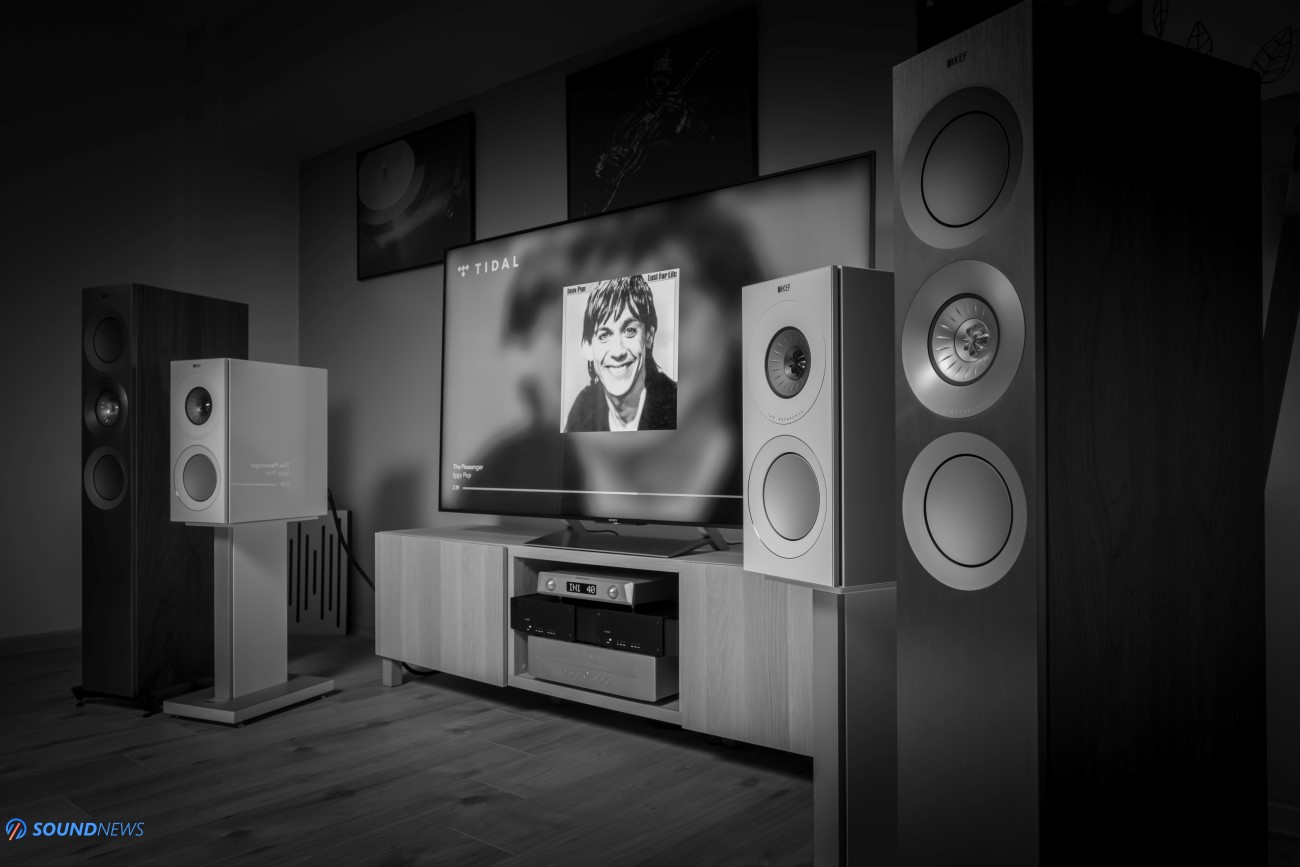
VI. Detail Retrieval & Transparency
I’m always having a good laugh when people are calling entry level R-2R ladder DACs as clean and detailed sounding. By definition, R-2R ladder DACs can’t be that clean sounding, as every single step of the ladder will be slashing bits of information, lowering the dynamic range and that’s why only a handful of units were approaching a dynamic range of 20-bits. Obviously, higher numbers can be obtained, but for that you’ll need the highest precision and hand matched resistors, the most accurate crystal clocks, the lowest impedance capacitors and the most over-engineered power supply. If there’s an FPGA that solves the errors made by the R-2R ladder, then we’re talking about high-performance R-2R converters and you know what? Terminator Plus is certainly part of this (very) short list. Denafrips Ares wasn’t that impressive in here, Venus felt way clearer sounding to a point of becoming transparent with live recordings, but Terminator Plus was playing in the big boy’s league, trying to push all the macro and micro details forward, without making it hard and aggressive sounding. More importantly (at least to me) it wasn’t trying to sharpen the leading edge and modernize older recordings, browsing through bad-mastered music without adding a sense of discomfort. Terminator Plus is a more forgiving digital creature, often times trying to show the beautiful side of your music. There are many albums that I don’t enjoy as much via chip-based converters, but with Terminator Plus is like slicing butter with a hot knife. With it, I can take bad-mastered & mediocre sounding music on bad days and there would be something that would latch onto my soul: hey look how clear and natural that guitar is, how deep that voice could go, how vibrant violins are playing and how deep bass guitars could go without making me lower the volume. The usual greyness and pot holes aren’t as bumpy and distracting anymore…I can see it beatifying my music little by little, I know that it lies to me…but these are beautiful lies that I want to hear.
This part isn’t its strongest skill and you aren’t getting an end-game R-2R ladder DAC for this chapter alone, as you can get a better transparency and cleanness per dollar with chip-based converters. However, from a sea of resistor ladder DACs, Terminator Plus came pretty darn impressive. It wasn’t exactly squeaky clean as I would define Gustard’s X26 PRO or Matrix Audio Element X, but it was trying to put as much information on the table, so I wouldn’t miss the smallest details from my usual audiophile diet. You can get clean, transparent and detailed sounding R-2R units, but that happens only with top-of-the-line units and Terminator Plus is a testament to that.

VII. Adding a Denafrips GAIA DDC into the Mix
The fine guys of Vinshine Audio did also sent a Denafrips GAIA DDC or digital to digital converter for a closer inspection. Besides offering a wide variety of inputs and outputs, GAIA’s main job is to clean up the mess that happens before your DAC. What happens inside your DAC is obviously very important, but surprisingly…what happens before it is equally important and that’s the main reason people use dedicated transports, digital enhancers, audiophile tuned PC, dedicated streamers, S/PDIF or DDC converters a lot more often than USB ports of a PC or MAC. GAIA isn’t your regular DDC, but more like The Best current production DDC that money could buy and that can be felt immediately after popping its hood, but especially after music starts playing with it.
On its own and via a USB input of my PC, Terminator Plus already proved itself clean, noiseless and distortion free, but with a GAIA in between it and my PC, the tiniest details felt even sharper, clearer and more defined. The change was immediate, regardless of the material that was playing. Terminator Plus started pushing more information on the micro scale, small nuances took a few steps forward into the light and everything that has been said about top-class delta-sigma converters slowly but surely made its way into the Terminator Plus. The whole experience felt clearer, but also smoother and more organic sounding to me. That slight delay and digitus of 16-bit PCM files was completely cured as if I swapped them with proper DSD files. Music started flowing more naturally, binding musical notes with invisible silk threads and I could hardly write additional words from this point onwards. The huge benefits of using the GAIA weren’t limited to Denafrips units, as regular chip-based converters worked with it too. I have at my disposal three DDC converters (GAIA, Gustard U18 and Singxer SU-6) and I’ve used a few more in the past, but I’m comfortable saying that GAIA is so far the lushest, the smoothest and most organic sounding of them all, like I traded digital files with LP records – a very weird feeling that completely removed grain, digitus and listening fatigue, while boosting transparency and detail retrieval a little higher.
Do note that I2S input (via HDMI) wasn’t standardized yet, meaning that you’ll need to use its user manual and manually adjust its I2S pin configuration, so it can work with your DAC. It works by default with all Denafrips and Musician DACs, but some fine adjustments are needed for it to work with other converters.
Long story short, GAIA was able to add a higher level of refinement all over my music, it added huge quantities of flow, easiness, while boosting transparency and inner detail to higher levels. I will be parting ways with the Terminator Plus as soon as this review goes live…but I will most likely purchase the GAIA, as I refuse using my DACs via a USB connection anymore.
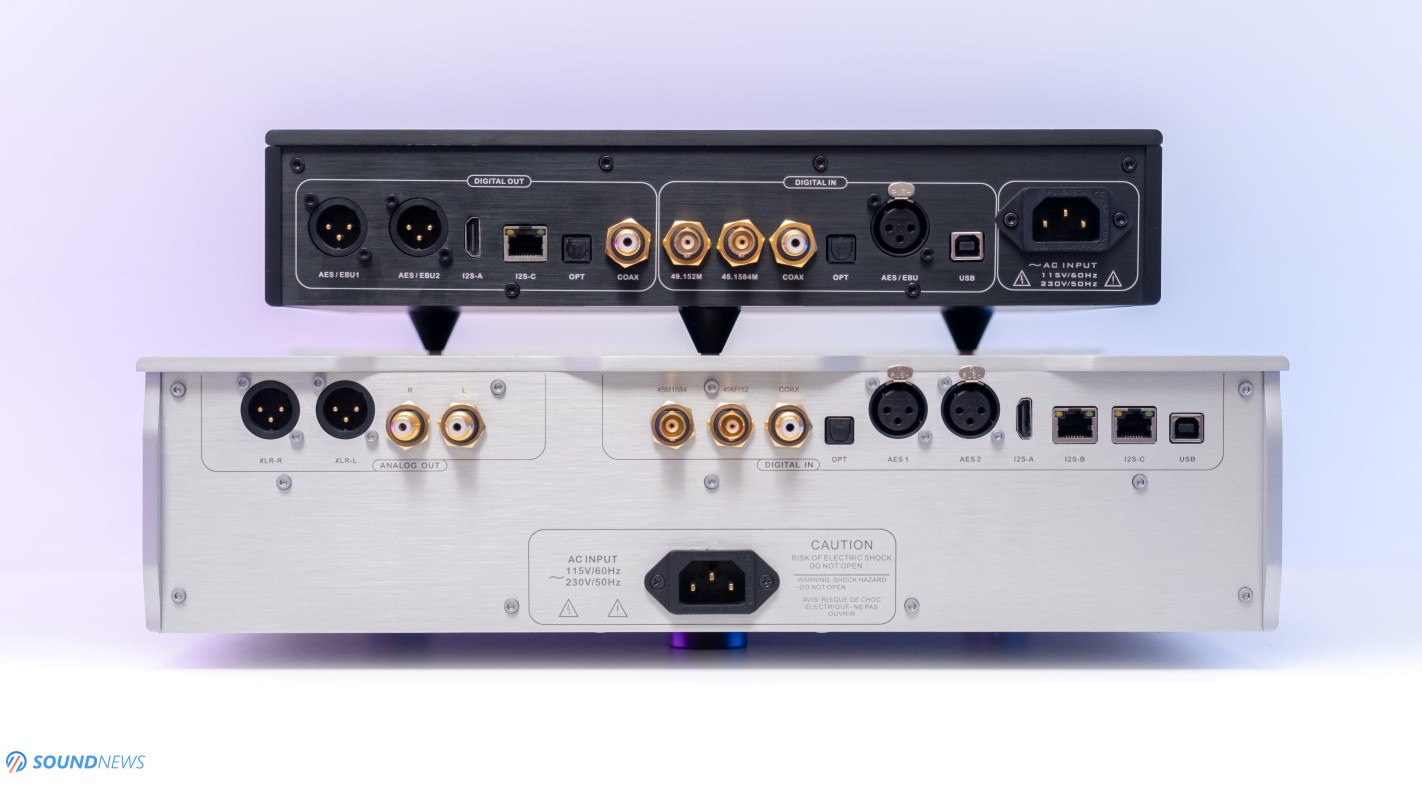
VIII. Frequency Response
A. Bass
There were quite a few DACs that impressed me right away with their deep rumbling bass, just naming a few: Gustard X26 PRO, Audio-GD R7 and Rockna Wavelight were very impressive in here, but Terminator Plus is a scarier animal altogether, providing a thicker, deeper reaching and a stronger bass output. Combine it with a hard-slamming amplifier like Trafomatic Primavera or AHB2 by Benchmark and you’ll arrive in bass heaven before you could say Jack Robinson. It fights in the heavyweight category, always landing heavy punches below the belt, but it’s doesn’t move as swift as smaller D/S DACs are doing. You are getting gobs of authority in the bass at the cost of a mellower performance throughout the entire frequency range. No matter if it was sub or mid-bass, Denafrips best unleashed the full force of the low-end, but it wasn’t racing for the first place on the podium when it comes to speed. This is one of the fullest sounding bass I’ve experienced and if you want to improve its speed and definition, then Denafrips GAIA would give a helping hand.
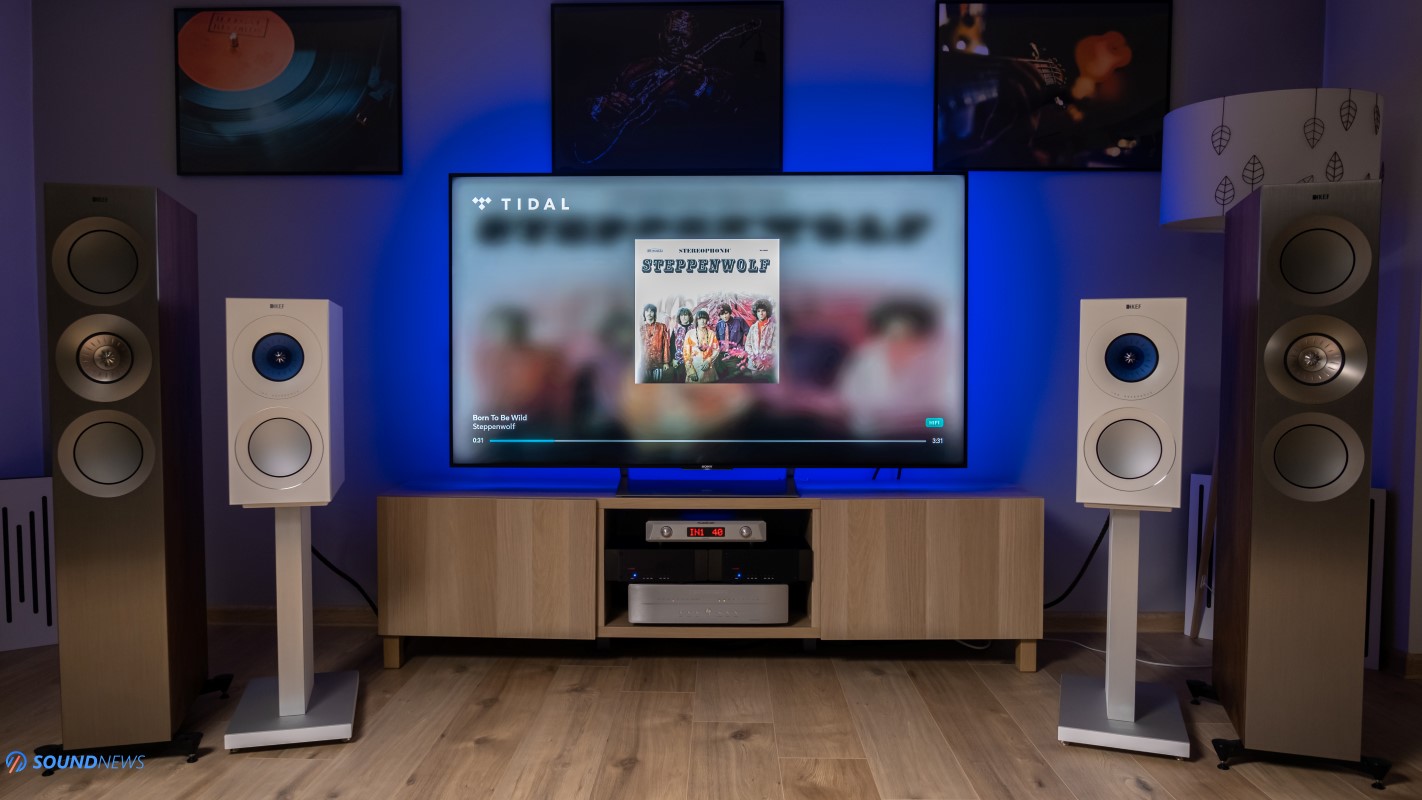
B. Midrange
It doesn’t come as a surprise as most R-2R units have a soul-grabbing midrange, a denser and a much fuller tonality. If you’re hunting for a richer midrange delivery, then from all digital-to-analog conversion techniques, I believe that R-2R units would impress you’re the most, especially if we’re talking about Non-Oversampling units, followed by software defined FPGA devices and then by chip-based converters. The first ones always shinned brighter and I’m adding the Terminator Plus in the same bandwagon. Compared to lower-grade R-2R units, the quality of the midrange improved tremendously, it’s much cleaner sounding now, more tactile, defined and involving sounding than ever before, thanks to an improved pace, rhythm and timing. You can’t remain unimpressed with its soul-grabbing midrange that is slightly thicker and sweeter sounding to smaller Denafrips units. It feels juicier and more saturated in here, like boosting the colors on a high-resolution picture, I can’t get enough from my blues and jazz collection thanks to its natural sounding midrange.
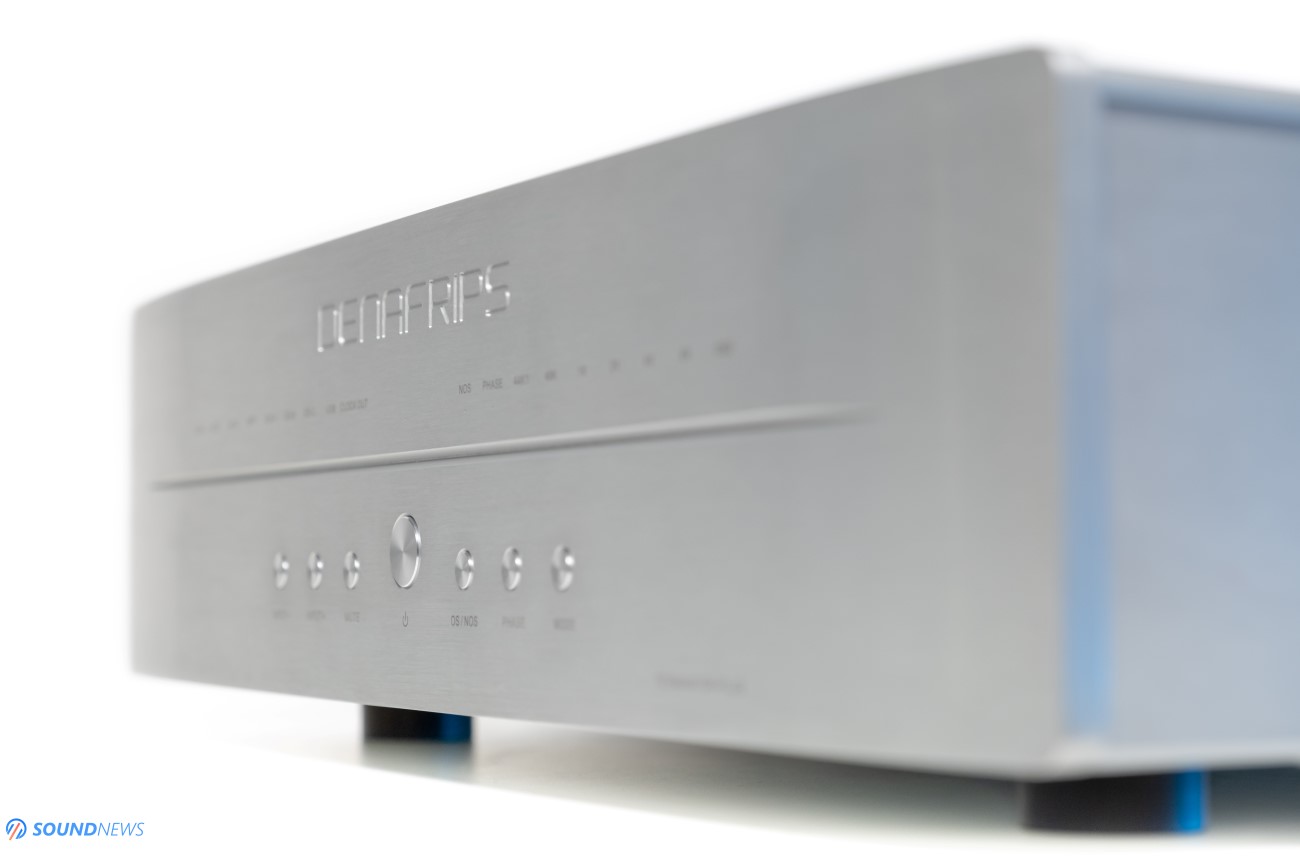
C. Treble
Another pleasant surprise was spotting more nuances and micro-details in the treble region. Usually, treble feels as a double-edged sword with such units, as you’ll surely get a grain free treble delivery, at the cost of less impressive clarity and definition. Since we are talking about a no-compromise unit, even its treble delivery felt clearer, more textured to their past doings, yet brightness free at all times. Higher-pitched sounds were detailed and quite transparent, lacking listening fatigue that you might get from affordable digital sources. I’m not getting roll-offs past top-octave, as it goes for a detailed but non-aggressive treble delivery. If you’re hunting for a more relaxed treble delivery, then you can simply enable its NOS mode and if you would like some extra crispness and definition, then enable its OS mode for a sharper and more contoured treble delivery.
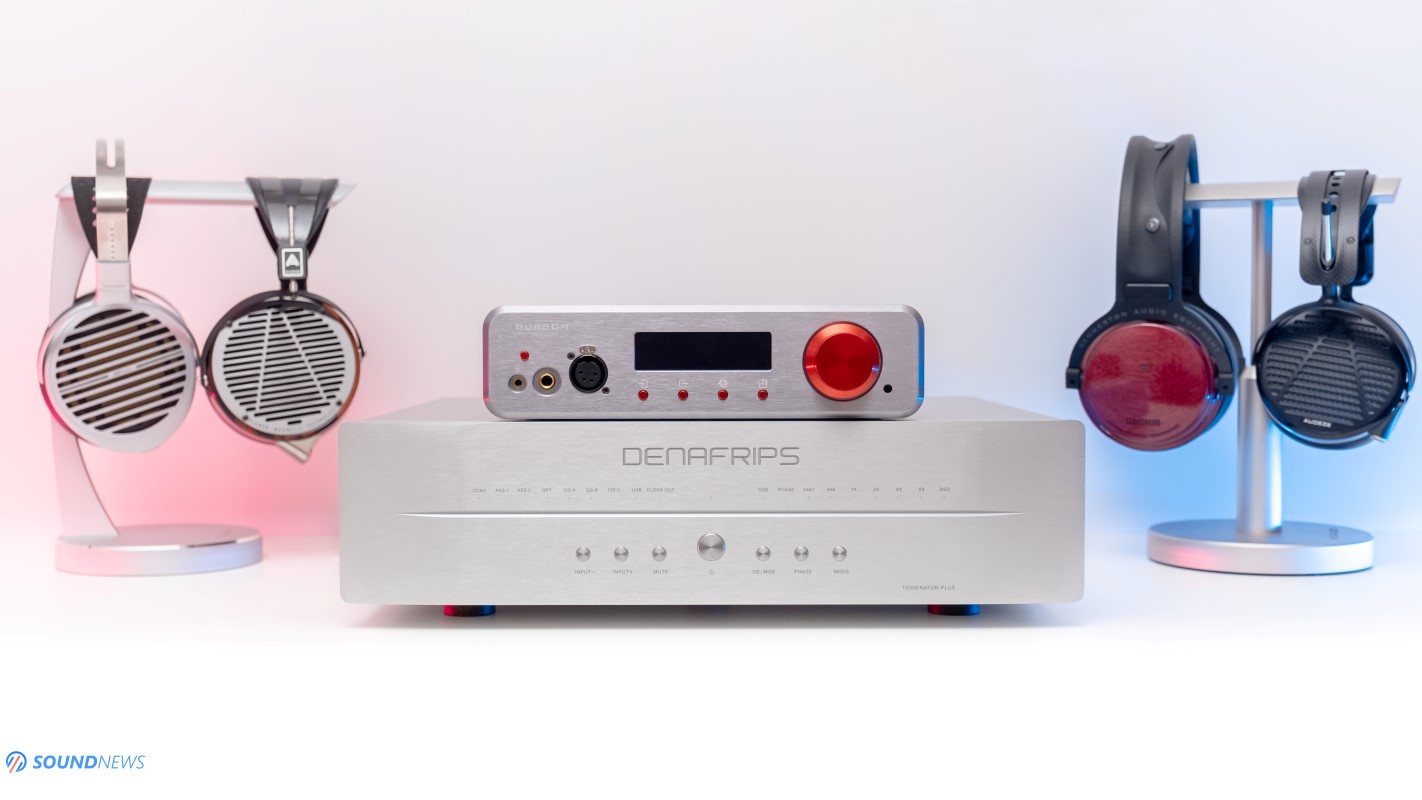
My Conclusion
Denafrips Terminator Plus doesn’t have a preamp stage, it doesn’t have a remote control, it’s not the most technical sounding machine, it’s not the fastest or the most detailed sounding unit out there, but it’s the best goose bump generator I’ve experienced in years. You can elevate its performance at a later date by adding a Denafrips Gaia DDC in between it and your source, but even without it in place, I was rocking hard, becoming sad, happy or excited depending on the music that’s was playing. It was sending a clear signal to me and if you’re after similar, emotional experiences, if you’re after a breathable type of sound, hefty bass, full-bodied midrange and clear but inoffensive trebles, then Denafrips Terminator Plus is the easiest recommendation to make.
It didn’t limit dynamics, the frequency extremes or the punch in chest as it happened with lower-tiered R-2R devices and I wouldn’t forget its body slams, its organic and life-like presentation anytime soon. It might look like an expensive unit at first, but considering its best-in-class components and everything that makes it tick, it’s my pleasure awarding it with our highest badge. Gold Award was fully deserved as it reflects all I think about it as a whole.

Denafrips Terminator Plus DAC and Gaia DDC were kindly loaned by their sole world-wide distributor Vinshine Audio and you can get them by following these links (1) (2). If you get any of them, please say hello to Alvin from me and leave a comment below.
PROS:
- Masterfully crafted unit, minimalist industrial design
- Built like tank, top-notch build quality
- The most impressive part selection I’ve seen on a DAC
- Overkill analog output stage and power supply implementation
- Noise and distortion free unit, offered a black as night background at any volumes
- Considerably clearer and more detailed sounding to lower tiered Denafrips units
- The most holographic, open and wide sound scape I’ve experienced with digital audio
- Deep sounding as Mariana Trench, impressive depth, layering and imaging
- Hefty and bold, punchy and visceral sounding with bass intensive music
- Dynamics were playful and alive, very enjoyable sounding at all times
- Full-bodied, organic and natural sounding, carries a warmer tonality
- Covers the frequency response in full, without roll-offs in the lowest or highest regions
- Widest selection of digital inputs
- Outstanding performance for the price
- Could still be improved with external Clock Generators
CONS:
- It’s only a DAC, nothing more and nothing less
- Not the most detailed sounding unit in its stock form
- Not the fastest sounding unit in its stock form
- If you want to squeeze the absolute best out of it, Denafrips GAIA is a must-have upgrade
ASSOCIATED EQUIPMENT:
- DACs: Denafrips Terminator Plus, Rockna Wavelight, Audiobyte HydraVox & HydraZap, Gold Note DS-10 Plus & PSU-10 EVO, FiiO K9 PRO ESS, Gustard X18
- DAPs: Hiby RS6, R5 Gen2, FiiO M17, M11 Plus ESS, Shanling M7
- Headphone Amps: Trafomatic Primavera, Enleum AMP-23R, Ferrum OOR + Hypsos, Flux Lab Acoustics Volot, Burson Audio Soloist 3X GT, several Topping, SMSL & Gustard units
- Preamps: Musician Monoceros
- Integrated Amps: Enleum AMP-23R, Burson Timekeeper 3i
- Power Amps: Benchmark AHB2 (x2)
- IEMs: FiiO FH9, FH7, FA9, FD7, Meze Rai Penta, LittleDot Cu KIS, Kinera Skuld, 7Hz Timeless & others
- Full-sized headphones: Hifiman Susvara, HE1000SE, Arya Stealth, Audeze LCD-5, LCD-4, Erzetich Phobos V2021, Phobos V2018, Erzetich Mania, Kennerton Rognir, Magni, Gjallarhorn, Vali, M12S, Apos Caspian, Sendy Peacock, Apollo, Aiva & others
- Loudspeakers: KEF Reference 3, Reference 1 Meta, Sound Of Eden Crescendo UNO
- Interconnects: QED Reference (x2), Topping TCX1 (x2)
- Speaker cables: Kimber PR8, Audioquest Type4
- Power Cables: Isotek EVO3 Premier (x3), iFi Audio SupaNova (x2)
- Balanced Isolation Power Conditioners: PLiXiR Elite BAC1500 (stereo setup), Elite BAC400 (headphone setup)
